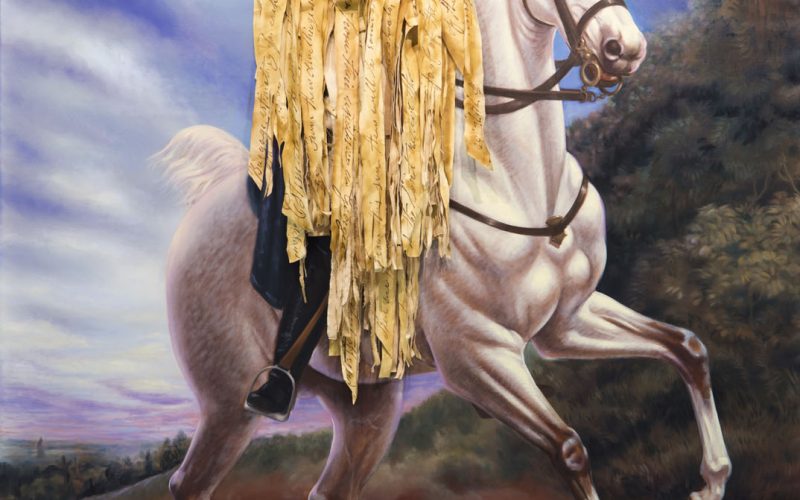Crystal Bridges furthers inclusive initiatives

Photo courtesy: Crystal Bridges Museum of American Art, Bentonville, Arkansas
Titus Kaphar’s “The Cost of Removal” is a new acquisition for the Crystal Bridges permanent collection and will be displayed in the 1940s to Now gallery. The piece investigates historical subjects through the lens of current events to call attention to who and what is memorialized or forgotten.
Be It Resolved
Crystal Bridges Museum of American Art in Bentonville has established itself as an internationally significant voice in presenting the American experience through art, continually offering new ways to engage and challenge visitors.
The Past
When Crystal Bridges opened in 2011, staff anticipated 200,00 to 300,000 yearly visitors for the region’s first American art museum. Far exceeding that expectation, more than 3.5 million people have stepped through the museum’s doors, which includes the nearly 165,000 visitors to the Bachman-Wilson House designed by Frank Lloyd Wright and opened at its new Crystal Bridges home in November of 2015; more than 200,000 school children participating in free field trips through the Willard and Pat Walker School Visit Program; and the 207,000 guests drawn by the sculptures of world-renowned glass blower Dale Chihuly between May and November of this year. The permanent collection has grown from 1,555 to more than 2,507 pieces, and Crystal Bridges provides 800 educational programs and special events throughout the year, up from 40 in the first year of operations.
The Present
In exploring ways to appeal to a wider audience, museum curators began a project some time ago of incorporating modern sculptural works alongside pieces in earlier galleries. In response to a positive reception, Crystal Bridges will close its early American art galleries for two months to redesign the space for the first time since opening.
“It’s one thing to be able to provide visitors with temporary exhibitions that are able to explore certain topics or artists in great depth, but this is our way of making sure our own collection galleries stay just as relevant and exciting as our temporary exhibitions,” says curator Mindy Besaw. “We’re not doing anything horribly wrong in our early American galleries. But we can make it so much better and relevant, so why not do some experimentation to see what would happen if we looked at these things differently?”
Crystal Bridges will also incorporate works on loan from other museums into the redesign, including Spanish Colonial and American Indian art to provide more “texture” to the work on display. A collaboration with the University of Arkansas to provide some pre-1400s American Indian objects will further help guests see the complexities of American art and history.
The Colonial to Early 19th Century and Late 19th Century galleries will be inaccessible to guests from Jan. 9 until the scheduled reopening of the galleries in early March.
Another area already fresh from redesign is the North Forest where “Chihuly: In the Forest,” the highest-attended exhibition in the museum’s history, was on display from May to November. Reopening on Dec. 23, the forest is now home to four sculptures from the permanent collection including two recent acquisitions. Indoors, two other new acquisitions increase the diversity of the 1940s to Now gallery: Titus Kaphar’s “The Cost of Removal” and Fritz Scholder’s “Indian Land #4.”
One piece from the outdoor half of the Chihuly exhibition managed to stick around as community members participated in a contest, voting on which sculpture would be purchased for the museum’s permanent collection. Nearly 20,000 votes divided among four pieces resulted in visitors choosing to keep the “Fiori Boat” — a wooden rowboat filled with 179 colorful spheres and batons.
The Future
Crystal Bridges maintains its commitment to presenting diverse perspectives in 2018 with a timely, but potentially controversial schedule for temporary exhibitions and distinguished speakers. “Soul of a Nation: Art in the Age of Black Power,” a dive into the experience of black artists in America from the 1960s through the 1980s, opens in February as Crystal Bridges hosts the American debut and one of only two state-side stops for the exhibition organized by the Tate Modern in London.
The following two exhibitions — on the legacy of Georgia O’Keeffe and a presentation of works by Native North American artists — were curated by Crystal Bridges staff and will later go on to show at other museums nationally — and perhaps even internationally as the museum seeks to expand the influence of its in-house scholarship.
— Robbie Neiswanger contributed to this story.



